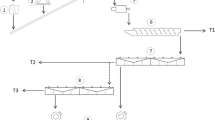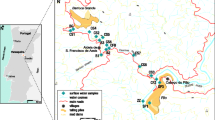Abstract
A total number of eight (8) tailings dams are found at the Kirki flotation plant and are either built on impermeable Neogene formations or permeable alluvial deposits of the Kirkalon and Eirini streams. The tailings dams were originally constructed without any environmental concerns, nowadays their embankments are highly eroded, and toxic material is readily transported to the nearby streams, resulting in degradation of the quality of both stream waters and sediments. Stream water sampling revealed that concentrations of dissolved Pb, Mn, Cd and SO4 increase rapidly in the vicinity of the Kirki flotation plant. Four case-specific PHREEQC scenarios were employed including “Direct Precipitation,” “Evaporation,” “Mixing with Rain water” and “Mixing with Stream water” in order to investigate the effect of interaction between water accumulated on the surface of the tailings dams and the precipitation or dissolution of heavy metal-bearing phases that may control heavy metal solubility. All tests performed concluded that such interaction plays a very important role in the environmental behavior of the toxic tailings material of the Kirki flotation plant. Based on the results of the PHREEQC tests, the proposed rehabilitation plan includes the construction of a sealing system in order to eliminate tailings dam wall erosion and infiltration effects. The suggested plan is limited to dams 2, 3, 4, 5, 6, 7 and 8, whereas dam 1 is empty and requires no remediation. Additionally, and only for dams 5, 7 and 8, built on top of permeable alluvial formations a few meters above the ground water head, chemical improvement of the tailings material is suggested to limit toxic pollutants dissolution. In particular, installation of lime piles is proposed in order to further improve the quality of possible small-scale, low-quality percolating solutions that might migrate to underground aquifers.








Similar content being viewed by others
References
Allison JD, Brown DS, Novo-Gradac KJ (1991) MINTEQA2/PRODEFA2, A geochemical assessment model for environmental systems, Version 3.0 User’s Manual, Environmental Research Laboratory, Office of Research and Development, US Environmental Protection Agency, EPA/600/3-91/021, Athens, Georgia, 30605, p 92
Arikas K (2007) Mineralogical and geochemical study of the Kirki mining wastes, Evros region, Greece- determination of the environmental impact by toxic and heavy metals, In: Proceeding of 11th international conference of the Geological Society of Greece, XXXX, pp 1343–1353
Arikas K, Asfahani N, Nowak A, Goetz D (2007) The Kirki mine in Evros Prefecture, NE Greece, and considerations on the environmental impact—part I: geochemical and mineralogical study of the tailing ponds and mineral concentrates. Min Metall Ann 17:21–50
Bigham JM, Nordstrom DK (2000) Iron and aluminum hydroxysulfates from acid sulfate waters, In: Alpers CN, Jambor JL, Nordstrom DK (eds) Sulfate minerals. Crystallography, geochemistry and environmental significance. Mineralogical Society of America Reviews in mineralogy and geochemistry, 40, 351–403
Carroll D (1962) Rainwater as a chemical agent of geologic processes—a review, U.S. Geological Survey, Washington, Water-Supply Paper 1535-G, p 23
Demou E (1993) Comparative and mineralogical study of the Achia Tarla and Ag. Filippos mineralisations (Kirki, NE Greece). Bull Geol Soc Greece 28, 2, 37–54 (in greek with English abstract)
Directive 98/83/EC of the Council, on the quality of water intended for human consumption, 3 November 1998
Draves JF, Fox MG (1998) Effects of a mine tailings spill on feeding and metal concentrations in yellow perch (Perca flavescens). Environ Toxicol Chem 17:1626–1632
Eary LE, Jakubowski R, Eshelman J, Watson A (2008) Applying numerical hydrogeochemical models as decision support tools for mine closure planning, In: Tailings and Mine Waste ’08, Proceedings of the 12th international conference, Vail, Colorado, USA, 19–22 October 2008. Taylor and Francis Group, London, pp 221–231
Evangelou VP (1983) Pyritic coal spoils: their chemistry and water interactions. In: Augustithis SS (ed) Leaching and diffusion in rocks and their weathering products, Theophrastus Publications S.A., Athens, Greece, pp 175–228
Fergusson JE (1990) The heavy metal elements: chemistry, environmental impact and health effects. Pergamon Press, Oxford, p 614
Groudev S, Batkova SG, Komnitsas K (1999) Treatment of waters polluted with radioactive elements and heavy metals by means of a laboratory passive system. Miner Eng 12(3):261–270
Heikkinen PM, Räisänen ML, Johnson RH (2009) Geochemical characterisation of seepage and drainage water quality from two sulphide mine tailings impoundments: acid mine drainage versus neutral mine drainage. Mine Water Environ 28(1):30–49
Hudson-Edwards KA, Macklin MG, Jamieson HE, Brewer PA, Coulthard TJ, Howard AJ, Turner JN (2003) The impact of tailings dam spills and clean-up operations on sediment and water quality in river systems: the Rios Agrio-Guadiamar, Aznalcollar, Spain. Appl Geochem 18:221–239
Jambor JL (1994) Mineralogy of sulfide-rich tailings and their oxidation products, In: Jambor JL, Blowes DW (eds) The environmental geochemistry of sulfide mine-wastes, Short Course Handbook 22, Mineral. Assoc. Canada, Waterloo, Ontario
Komnitsas K, Kontopoulos A, Lazar I, Cambridge M (1998) Risk assessment and proposed remedial actions in coastal tailings disposal sites in Romania. Miner Eng 11(12):1179–1190
Konstantopoulou G, Loupasakis C (2007) Geotechnical study on the stability of the abandoned tailing ponds of the Kirki mines, Thrace District, Greece, unpublished technical report, Greek Institute of Geology and Mineral Exploration, Athens
Lacal J, Da Silva MP, Garcsia R, Sevilla MT, Procopio JR, Hernandez L (2003) Study of fractionation and potential mobility of metal sludge from pyrite mining and affected river sediments: changes in mobility over time and use of artificial ageing as a tool in environmental impact assessment. Environ Pollut 124(2):291–305
Larsen TS, Kristensen JA, Asmund G, Bjerregaard P (2001) Lead and zinc in sediments and biota from Maarmorilik, west Greenland: an assessment of the environmental impact of mining wastes on an Arctic fjord system. Environ Pollut 114:275–283
Liakopoulos A (2009) Environmental study of the former Kirki mines area. Pollution extension and proposed abatement measures, Institute of Geology and Mineral Exploration, Athens, Greece (in Greek), p 257
Lottermoser BG (2010) Mine wastes. Characterization, treatment and environmental impact. Springer, Berlin, p 400
Loupasakis C, Konstantopoulou G (2010) Safety assessment of abandoned tailings ponds: an example from Kirki mines, Greece. Bull Eng Geol Environ 69:63–69
Manchester JB, Eykholt GR, Donohue SV, Cherry JC (2008) Water chemistry and metal cycling in a subaqueous tailings disposal facility, In: Tailings and mine waste’08, Proceedings of the 12th international conference, Vail, Colorado, USA, 19–22 October 2008. Taylor and Francis Group, London, pp 49–61
Mascaro I, Benvenuti B, Corsini F, Costagliola P, Lattanzi P, Parrini P, Tanelli G (2001) Mine wastes at the polymetallic deposit of Fenice Capanne (southern Tuscany, Italy). Mineralogy, geochemistry, and environmental impact. Environ Geol 41:417–429
Michael K, Dimadis E (2006) Geological study of the area around the Kirki beneficiation plant, Institute of Geology and Mineral Exploration, Athens. Greece, (in Greek), p 40
Moelo Y, Oudin E, Makovicky E, Karup-Moller S, Pillard F, Bornuat M, Evanghelou E (1985) La Kirkiite, Pb10Bi3As3S18, une nouvelle espece minerale homologue de la jordanite. Bull Miner 108:667–677
Moelo Y, Makovicky E, Karup-Moller S, Cervelle B, Maurel C (1990) La levyclaudite, Pb8Sn7Cu3(Bi, Sb)3S28, une nouvelle espece a structure incommensurable, de la serie de la cylindrite. Eur J Miner 2:711–723
Mohamed AMO, Hossein M, Hassani FP (2002) Hydro-mechanical evaluation of stabilized mine tailings. Environ Geol 41:749–759
Papassiopi N, Zaharia C, Xenidis A, Adam K, Liakopoulos A, Romaidis I (2014) Assessment of contaminants transport in a watershed affected by acid mine drainage, by coupling hydrological and geochemical modelling tools. Miner Eng 64:78–91
Parkhurst DL, Appelo CAJ (1999) User’s guide to PHREEQC (version 2)—a computer program for speciation, batch-reaction, one-dimensional transport and inverse geochemical calculations, U.S. Geological Survey, Denver, Colorado, report 99-4259
Plumlee GS, Logsdon MJ (1999) An earth system science toolkit for environmentally friendly mineral resource development. In: Plumlee GS, Logsdon MJ (eds) The environmental geochemistry of mineral deposits. Part A: Processes, techniques, and health issues. Society of Economic Geologists, Reviews in Economic Geology, 6A, 1–27
Romaidis I (2007) Preliminary hydrogeological study of the Kirki mines area, Unpublished IGME internal report
Skarpelis N (1999) The Agios Filippos ore deposit, Kirki (Western Thrace). A base metal part of a high sulfidation epithermal system, Bull. Geol. Soc. Greece, XXXIII, 51–60
Skarpelis N, Triantafyllidis S (2004) Environmental impact from supergene alteration and exploitation of a high sulphidation epithermal type mineralisation (Kirki, NE Greece). Appl Earth Sci Trans Inst Min Metall B, 113, 1, 110–116
Sobek AA, Shuller WA, Freeman JR, Smith RM (1978) Field and laboratory methods applicable to overburdens and minesoils. EPA 600/2-78-054, U.S. Environmental Protection Agency, Cincinnati, Ohio, p 203
Stokes JL (1954) Studies in the filamentous iron bacterium Sphaerotilus natans. J Bacteriol 67:278–291
Triantafyllidis S (2006) Environmental risk assessment of mining and processing activities and rehabilitation proposals in Evros and Rhodope Prerefectures (Thrace, NE Greece), Unpublished Doctoral Thesis (in Greek), Faculty of Geology and Geoenvironment, University of Athens, Athens, Greece, p 378
Triantafyllidis S, Skarpelis N (2005) Mineral formation in an acid pit lake from a high sulfidation ore deposit: Kirki, NE Greece. J Geochem Explor 88:68–71
Triantafyllidis S, Skarpelis N, Komnitsas K (2007) Environmental characterization and geochemistry of Kirki, Thrace, NE Greece, abandoned flotation tailings dumps. Environ Forensic 8(4):351–359
USEPA (U.S. Environmental Protection Agency) (1986) Toxicity Characteristics Leaching Procedure, Appendix 1. Federal register 51(216)
USEPA (U.S. Environmental Protection Agency) (1996) Soil and Waste pH, Method 9045C, SW–846.: U.S. Environmental Protection Agency, Washington, DC, USA
Voudouris P, Papavasiliou C, Melfos V (2005) Silver mineralogy of St. Philippos deposit (NE Greece) and its relationship to a Te-bearing porphyry-Cu-Mo mineralization. Geochem Mineral Petrol 43:155–160
Walsh F, Mitchell R (1972) A pH-dependent succession of iron bacteria. Environ Sci Technol 6:809–812
Wray DS (1998) The impact of unconfined mine tailings and anthropogenic pollution on a semiarid environment—an initial study of the Rodalquilar mining district, southeast Spain. Environ Geochem Health 20:29–38
Acknowledgements
Part of the research work was funded through the program “IRAKLEITOS—Fellowships for Research of National and Kapodistrian University of Athens—ENVIRONMENT.”
Author information
Authors and Affiliations
Corresponding author
Rights and permissions
About this article
Cite this article
Triantafyllidis, S., Loupasakis, C. & Tsangaratos, P. Geochemical modeling-based rehabilitation proposal for abandoned sulfidic flotation mill tailings, Kirki, Thrace, NE Greece. Environ Earth Sci 75, 1403 (2016). https://doi.org/10.1007/s12665-016-6213-1
Received:
Accepted:
Published:
DOI: https://doi.org/10.1007/s12665-016-6213-1




